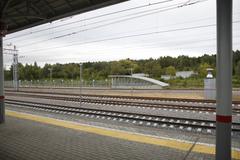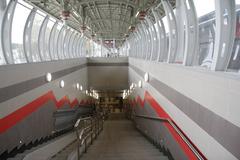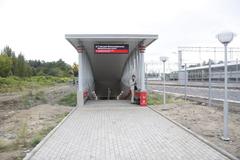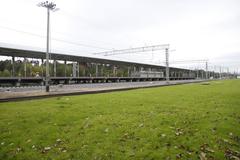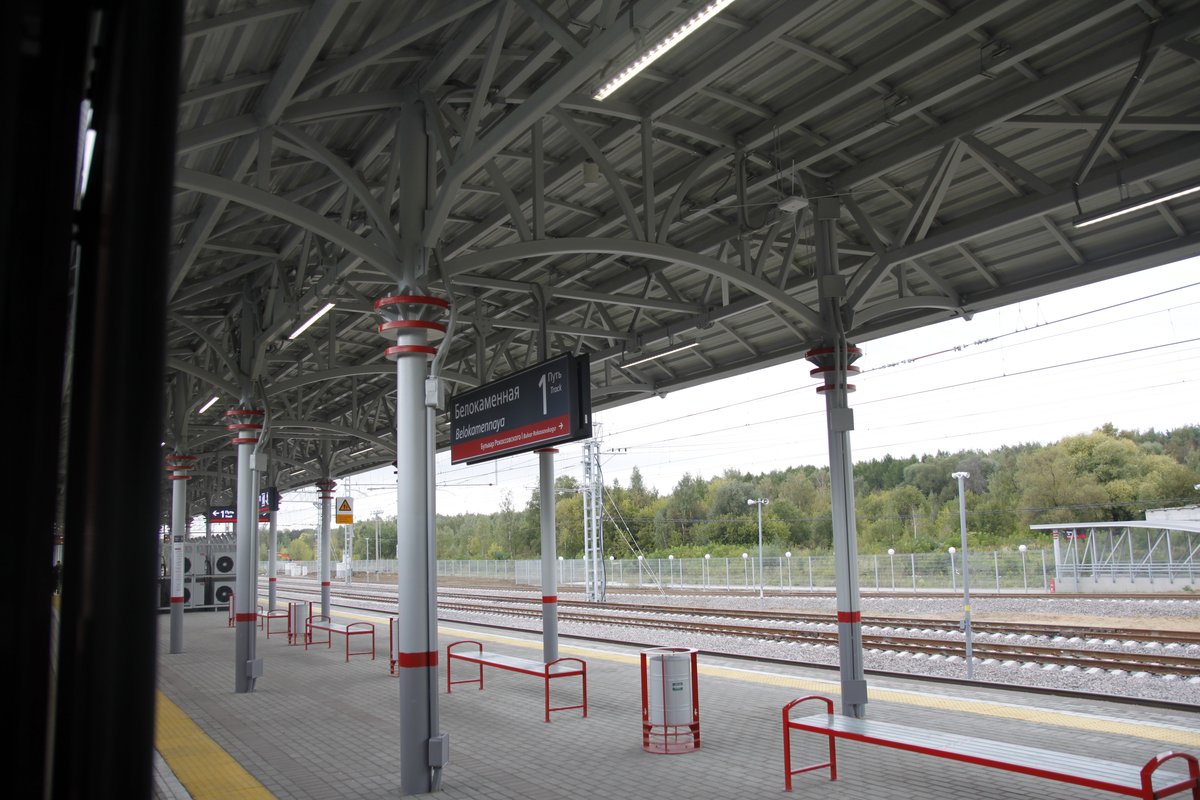
Belokamennaya Visiting Hours, Tickets, and Historical Sites in Moscow
Date: 14/06/2025
Introduction to Belokamennaya and Its Significance in Moscow
Belokamennaya Station, meaning “White-Stone,” is uniquely situated within the sprawling Losiny Ostrov National Park, offering a rare convergence of Moscow’s rich historical legacy and its natural environment. As a pivotal stop on the Moscow Central Circle (MCC), this station provides seamless access to one of Europe’s largest urban forests while linking visitors to Moscow’s extensive transit network. The name “Belokamennaya” pays homage to Moscow’s medieval identity, referencing the iconic white limestone that once fortified the city.
Having played a significant role since the early 20th century, Belokamennaya originally supported freight and military logistics during Moscow’s period of industrial expansion. Over time, it evolved into a commuter hub, now harmoniously blending functional modernism with historic architectural elements. Its location within Losiny Ostrov National Park—officially established in 1983 but protected for centuries—makes it a gateway to a landscape rich in biodiversity, history, and recreational opportunities.
This guide provides a comprehensive overview of Belokamennaya Station’s history, architectural features, role in Moscow’s railway network, and essential visitor information. It also covers Losiny Ostrov National Park’s ecological importance, top attractions, and practical tips for a rewarding visit to these interconnected Moscow landmarks.
For more background, see Belokamennaya Station and its heritage and Losiny Ostrov National Park.
Belokamennaya Station: History, Architecture, and Cultural Importance
Origins and Historical Context
Belokamennaya Station was established in the early 1900s as part of the Moscow Ring Railway, initially designed for freight and military transport to support the city’s industrial growth (Russia Beyond). As Moscow expanded, the station began serving local communities and commuters, its proximity to Losiny Ostrov National Park underscoring its dual significance as both a transport node and a cultural landmark (How to Russia).
Architectural Features and Preservation
The station’s architecture reflects early 20th-century Russian railway design: elegant yet utilitarian, with a focus on durability and public utility. Notable elements include period houses and the station building, which remain well preserved, offering a glimpse into pre-revolutionary Moscow (Russia Beyond). “Belokamennaya” also recalls Moscow’s historic white limestone fortifications (AirPano). As a protected cultural heritage site, Belokamennaya’s historic appearance is carefully maintained.
Role in Moscow’s Railway Network
Once a critical link in the 54-kilometer Moscow Ring Railway (opened in 1908), Belokamennaya facilitated both military and civilian transit (Russia Beyond). It now operates as part of the MCC, a modern orbital commuter rail system launched in 2016, solidifying its importance as an access point for both local commuters and visitors to Losiny Ostrov.
Cultural and Natural Significance
Belokamennaya’s unique setting within Losiny Ostrov National Park, known as “The Lungs of Moscow,” allows visitors to transition from the city’s bustle into a serene, protected wilderness. The station is a starting point for exploring the park’s dense forests, meadows, and diverse wildlife (How to Russia).
Visitor Information: Belokamennaya Visiting Hours and Tickets
- Operating Hours: The station is open daily from 5:30 AM to 1:00 AM, in line with MCC schedules.
- Tickets: Standard MCC fare applies. Use the Troika card for seamless metro, MCC, bus, and tram travel. Tickets are available via mobile apps, ticket machines, or station kiosks.
- Accessibility: Elevators and ramps ensure full accessibility. Multilingual signage assists international visitors.
Travel Tips and Accessibility
- Getting There: Easily accessible via the MCC (Line 14). Use the Troika card for convenience.
- Best Times to Visit: Spring through autumn offers pleasant weather. Early mornings are quieter, and autumn foliage is especially beautiful.
- Facilities: The station has basic amenities; nearby districts offer additional services. Plan ahead for food and restroom needs.
Exploring Losiny Ostrov National Park
Historical Background
Losiny Ostrov (“Elk Island”) is the largest urban forest in Europe, covering over 116 square kilometers (Wikipedia; Global National Parks). Its protected status traces back to the 15th century, originally serving as royal hunting grounds.
Ecological Significance and Biodiversity
The park is a haven for wildlife, supporting 44 mammal species (notably moose/elk), 170 bird species, and many amphibians and reptiles. Forests of birch, pine, spruce, and oak dominate the landscape, which also features wetlands and rivers vital to Moscow’s ecosystem (Wikipedia; My Guide Moscow).
Zoning and Conservation
- Specially Protected Area: No public access.
- Training and Excursion Zone: Restricted visits (educational/scientific).
- Recreational Zone: Open daily 7:00 AM–10:00 PM; free entry (VLV-mag).
Strict rules prohibit hunting, fishing, plant picking, and littering. The State Inspectorate enforces conservation (VLV-mag).
Visitor Information: Losiny Ostrov National Park
- Entry: Free to the recreational zone; guided tours or special events may require tickets.
- Access: Reachable via Metro (Medvedkovo, Babushkinskaya), buses, trams, and the MCC at Belokamennaya.
- Facilities: Ecological trails, picnic areas, visitor centers, and accessible paths for families and individuals with disabilities.
- Guided Tours: Available in English and Russian; advance booking recommended.
- Nearby Attractions: VDNKh exhibition center, Ostankino Tower, and accommodation options like Hanoi-Moscow aparthotel (Global National Parks).
Top Activities
- Hiking and Cycling: 13 ecological trails for all skill levels.
- Wildlife Observation: Best at dawn/dusk; observation platforms are available.
- Equestrian Activities: Horseback and pony rides.
- Environmental Education: Visitor centers offer eco-classes and exhibitions.
Practical Tips
- Dress Appropriately: Sturdy footwear and layered clothing are recommended.
- Supplies: Bring food and water; amenities are limited.
- Safety: Stay on trails, avoid isolated areas after dark, and carry ID.
- Pets: Allowed on leash in the recreational zone.
Accessibility
Both Belokamennaya Station and Losiny Ostrov offer accessible features, including ramps, tactile paving, and step-free paths, though some park trails may be challenging for wheelchairs or strollers.
Day Trip Ideas and Connectivity
- Sokolniki Park: Urban gardens and cafes (Holidify).
- Izmailovsky Market: Souvenir shopping and local crafts (Official Site).
- Moscow Historical Landmarks: Kremlin, Red Square, and more via MCC transfers.
Environmental and Cultural Etiquette
Respect park regulations: do not pick plants, feed animals, or light fires outside designated areas. Dress modestly and be courteous. Drones may be restricted.
Connectivity and Communication
Mobile coverage is generally good, but download maps in advance as Wi-Fi is unavailable. Basic Russian phrases or translation apps are helpful.
Safety and Travel Advisories
Both the station and park are safe during the day. For emergencies, dial 112. Review current travel advisories before visiting ([Official Travel Advisory Sites]).
Frequently Asked Questions (FAQ)
Q: What are Belokamennaya station’s visiting hours?
A: Open daily from 5:30 AM to 1:00 AM.
Q: Is there an entry fee for Losiny Ostrov National Park?
A: Free for the recreational zone; some events or tours require tickets.
Q: How do I get to Belokamennaya Station?
A: By MCC (Line 14); use the Troika card for transit.
Q: Is the station wheelchair accessible?
A: Yes, with elevators and ramps.
Q: Are there guided tours in the park?
A: Yes, in both Russian and English; advance booking recommended.
Q: Can I bring my bike?
A: Yes, many park trails are suitable for cycling.
Visuals and Media Suggestions
- Images: Include high-quality photos of the station, park trails, and wildlife. Alt tags such as “Belokamennaya Station exterior” and “Hiker in Losiny Ostrov National Park” aid accessibility and SEO.
- Maps: Embed interactive maps showing transport connections and park zones.
- Videos: Short video tours of the station and park entrance can enhance user engagement.
Summary of Key Points and Visitor Recommendations
Belokamennaya Station exemplifies Moscow’s blend of industrial heritage and natural grandeur, serving as both a practical transport hub and a cultural landmark. Its integration with Losiny Ostrov National Park allows visitors to experience the best of Moscow’s history and ecology in a single trip. Modern transport, accessible facilities, and comprehensive visitor information ensure a smooth and enjoyable visit.
Plan your journey using the Troika card, check operating hours, and consult official resources for the latest updates. Download the Audiala app for real-time guidance and follow Moscow Metro and park social media for event news and travel tips.
For more details, visit the official Losiny Ostrov National Park website and the Moscow Metro official site.
Sources and Further Reading
- Russia Beyond
- VLV-mag
- Wikipedia
- CityMonitor
- MetroLineMap
- Wikimedia Commons
- Official Site
- Global National Parks
- How to Russia
- Moscow Metro
- AirPano
- My Guide Moscow
- Holidify
- Official Site Izmailovsky Market
- Russiable
- Accessible EU Centre

